Contemporary Hotel Marketing Report: Family Traveler Insights
VerifiedAdded on 2020/05/04
|10
|1707
|32
Report
AI Summary
This report provides a comprehensive analysis of contemporary hotel marketing strategies, specifically focusing on the behavior and preferences of family travelers. The research delves into the tourism industry, examining the characteristics, needs, and buying patterns of family travelers to understand their decision-making processes when selecting a hotel. The report includes a situation analysis, exploring factors like travel motivation, cultural influences, and financial considerations that shape traveler behavior. A primary research methodology, involving questionnaires distributed during different seasons, was employed to gather data on demographics, travel frequency, and preferences. The findings reveal insights into gender, education levels, marital status, and travel habits, highlighting the importance of recreational activities, relaxation, and quality family time as key motivators for family travelers. The report concludes that family travelers are significantly influenced by situational and environmental factors, emphasizing the need for hotels to cater to these specific needs to strengthen family bonds and enhance customer satisfaction. The report references several research papers to support the findings.
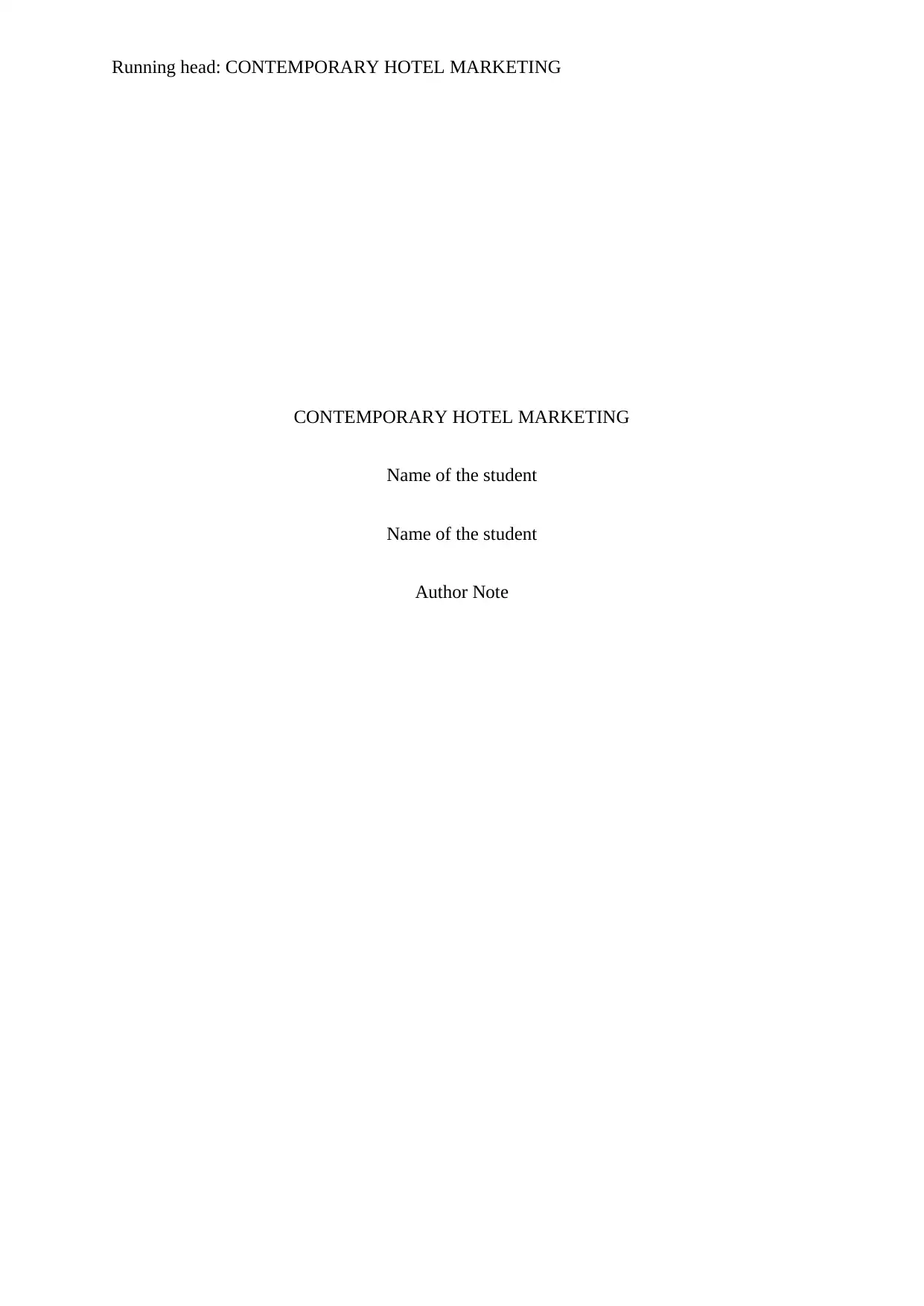
Running head: CONTEMPORARY HOTEL MARKETING
CONTEMPORARY HOTEL MARKETING
Name of the student
Name of the student
Author Note
CONTEMPORARY HOTEL MARKETING
Name of the student
Name of the student
Author Note
Paraphrase This Document
Need a fresh take? Get an instant paraphrase of this document with our AI Paraphraser
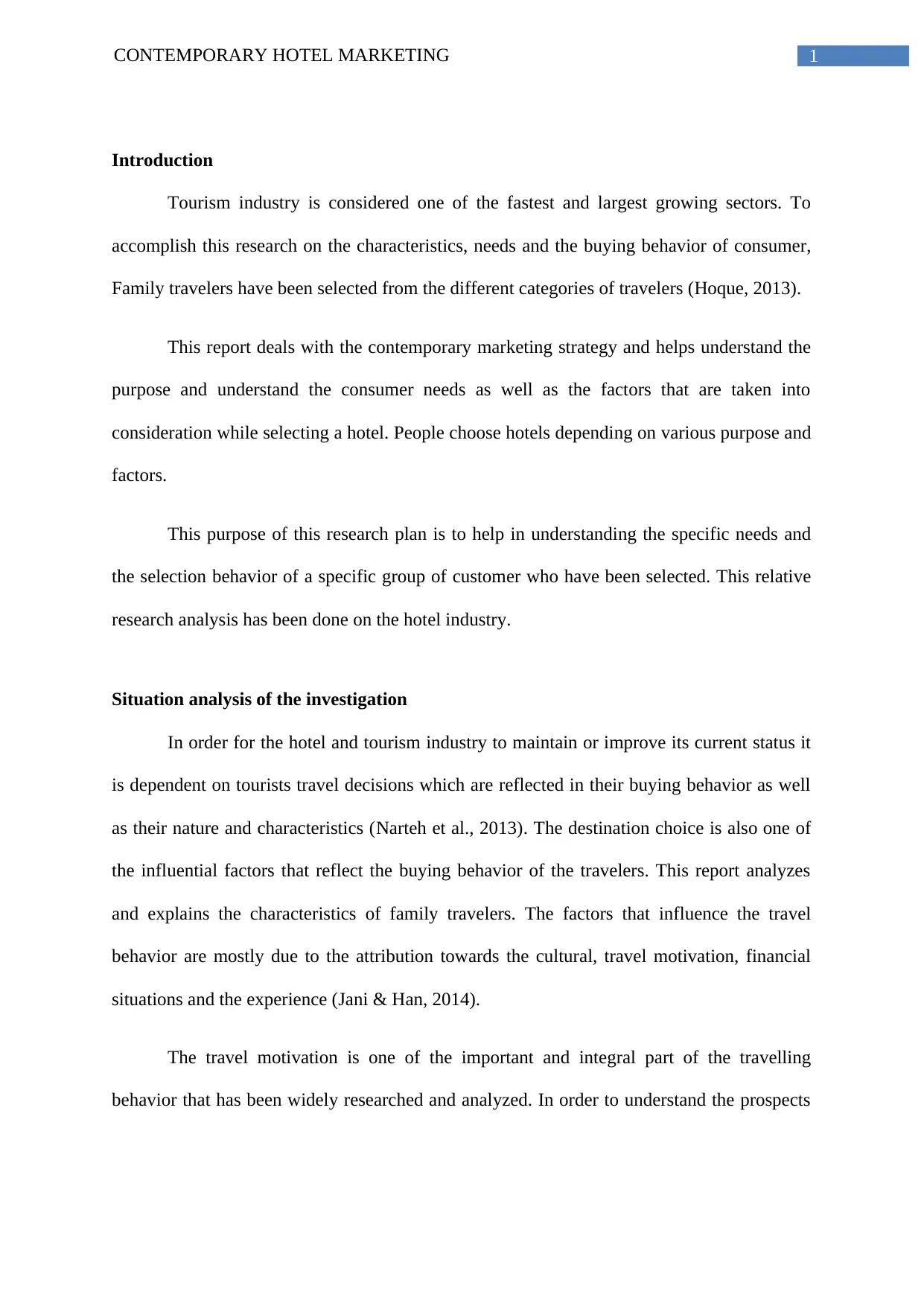
1CONTEMPORARY HOTEL MARKETING
Introduction
Tourism industry is considered one of the fastest and largest growing sectors. To
accomplish this research on the characteristics, needs and the buying behavior of consumer,
Family travelers have been selected from the different categories of travelers (Hoque, 2013).
This report deals with the contemporary marketing strategy and helps understand the
purpose and understand the consumer needs as well as the factors that are taken into
consideration while selecting a hotel. People choose hotels depending on various purpose and
factors.
This purpose of this research plan is to help in understanding the specific needs and
the selection behavior of a specific group of customer who have been selected. This relative
research analysis has been done on the hotel industry.
Situation analysis of the investigation
In order for the hotel and tourism industry to maintain or improve its current status it
is dependent on tourists travel decisions which are reflected in their buying behavior as well
as their nature and characteristics (Narteh et al., 2013). The destination choice is also one of
the influential factors that reflect the buying behavior of the travelers. This report analyzes
and explains the characteristics of family travelers. The factors that influence the travel
behavior are mostly due to the attribution towards the cultural, travel motivation, financial
situations and the experience (Jani & Han, 2014).
The travel motivation is one of the important and integral part of the travelling
behavior that has been widely researched and analyzed. In order to understand the prospects
Introduction
Tourism industry is considered one of the fastest and largest growing sectors. To
accomplish this research on the characteristics, needs and the buying behavior of consumer,
Family travelers have been selected from the different categories of travelers (Hoque, 2013).
This report deals with the contemporary marketing strategy and helps understand the
purpose and understand the consumer needs as well as the factors that are taken into
consideration while selecting a hotel. People choose hotels depending on various purpose and
factors.
This purpose of this research plan is to help in understanding the specific needs and
the selection behavior of a specific group of customer who have been selected. This relative
research analysis has been done on the hotel industry.
Situation analysis of the investigation
In order for the hotel and tourism industry to maintain or improve its current status it
is dependent on tourists travel decisions which are reflected in their buying behavior as well
as their nature and characteristics (Narteh et al., 2013). The destination choice is also one of
the influential factors that reflect the buying behavior of the travelers. This report analyzes
and explains the characteristics of family travelers. The factors that influence the travel
behavior are mostly due to the attribution towards the cultural, travel motivation, financial
situations and the experience (Jani & Han, 2014).
The travel motivation is one of the important and integral part of the travelling
behavior that has been widely researched and analyzed. In order to understand the prospects
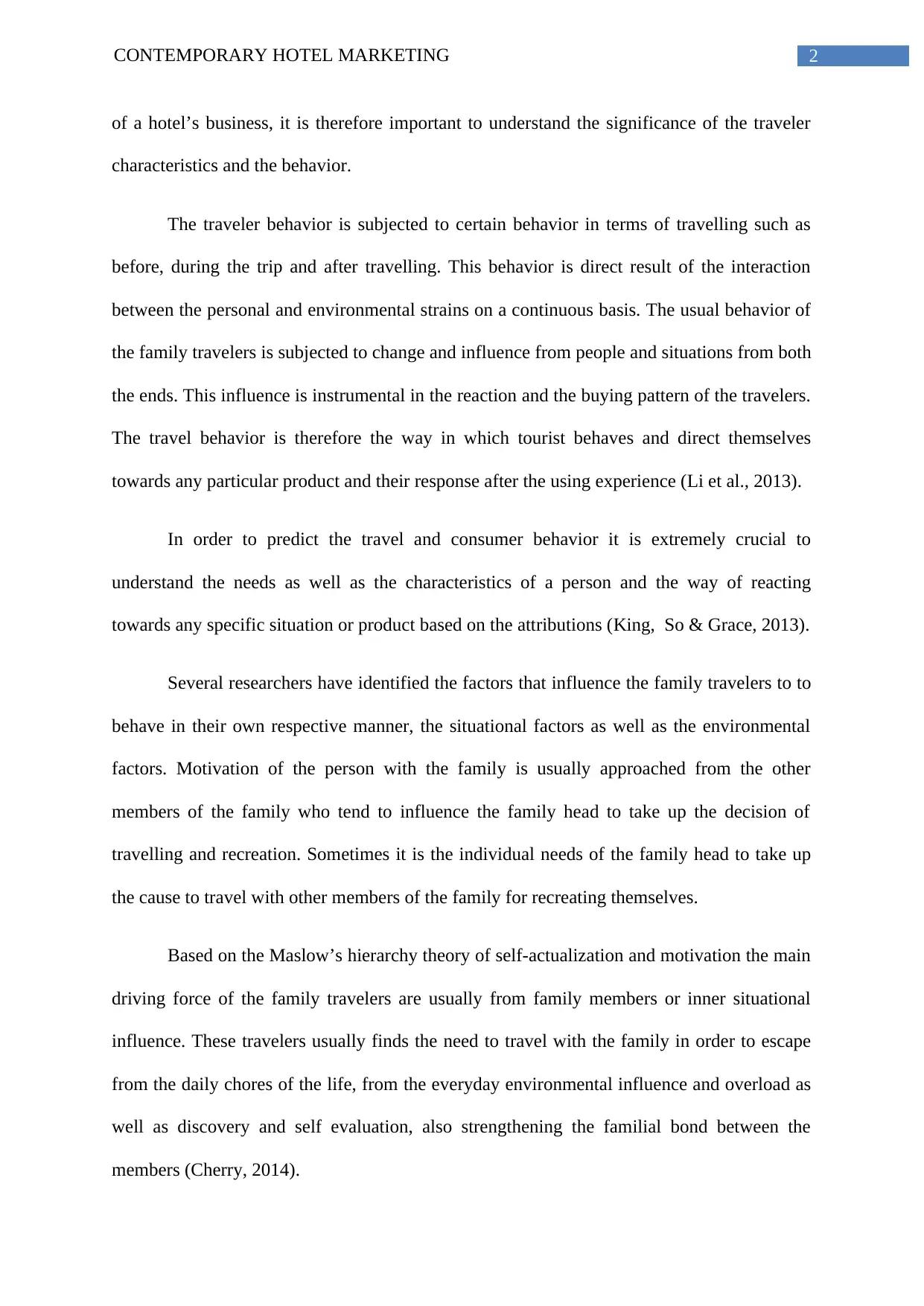
2CONTEMPORARY HOTEL MARKETING
of a hotel’s business, it is therefore important to understand the significance of the traveler
characteristics and the behavior.
The traveler behavior is subjected to certain behavior in terms of travelling such as
before, during the trip and after travelling. This behavior is direct result of the interaction
between the personal and environmental strains on a continuous basis. The usual behavior of
the family travelers is subjected to change and influence from people and situations from both
the ends. This influence is instrumental in the reaction and the buying pattern of the travelers.
The travel behavior is therefore the way in which tourist behaves and direct themselves
towards any particular product and their response after the using experience (Li et al., 2013).
In order to predict the travel and consumer behavior it is extremely crucial to
understand the needs as well as the characteristics of a person and the way of reacting
towards any specific situation or product based on the attributions (King, So & Grace, 2013).
Several researchers have identified the factors that influence the family travelers to to
behave in their own respective manner, the situational factors as well as the environmental
factors. Motivation of the person with the family is usually approached from the other
members of the family who tend to influence the family head to take up the decision of
travelling and recreation. Sometimes it is the individual needs of the family head to take up
the cause to travel with other members of the family for recreating themselves.
Based on the Maslow’s hierarchy theory of self-actualization and motivation the main
driving force of the family travelers are usually from family members or inner situational
influence. These travelers usually finds the need to travel with the family in order to escape
from the daily chores of the life, from the everyday environmental influence and overload as
well as discovery and self evaluation, also strengthening the familial bond between the
members (Cherry, 2014).
of a hotel’s business, it is therefore important to understand the significance of the traveler
characteristics and the behavior.
The traveler behavior is subjected to certain behavior in terms of travelling such as
before, during the trip and after travelling. This behavior is direct result of the interaction
between the personal and environmental strains on a continuous basis. The usual behavior of
the family travelers is subjected to change and influence from people and situations from both
the ends. This influence is instrumental in the reaction and the buying pattern of the travelers.
The travel behavior is therefore the way in which tourist behaves and direct themselves
towards any particular product and their response after the using experience (Li et al., 2013).
In order to predict the travel and consumer behavior it is extremely crucial to
understand the needs as well as the characteristics of a person and the way of reacting
towards any specific situation or product based on the attributions (King, So & Grace, 2013).
Several researchers have identified the factors that influence the family travelers to to
behave in their own respective manner, the situational factors as well as the environmental
factors. Motivation of the person with the family is usually approached from the other
members of the family who tend to influence the family head to take up the decision of
travelling and recreation. Sometimes it is the individual needs of the family head to take up
the cause to travel with other members of the family for recreating themselves.
Based on the Maslow’s hierarchy theory of self-actualization and motivation the main
driving force of the family travelers are usually from family members or inner situational
influence. These travelers usually finds the need to travel with the family in order to escape
from the daily chores of the life, from the everyday environmental influence and overload as
well as discovery and self evaluation, also strengthening the familial bond between the
members (Cherry, 2014).
⊘ This is a preview!⊘
Do you want full access?
Subscribe today to unlock all pages.

Trusted by 1+ million students worldwide
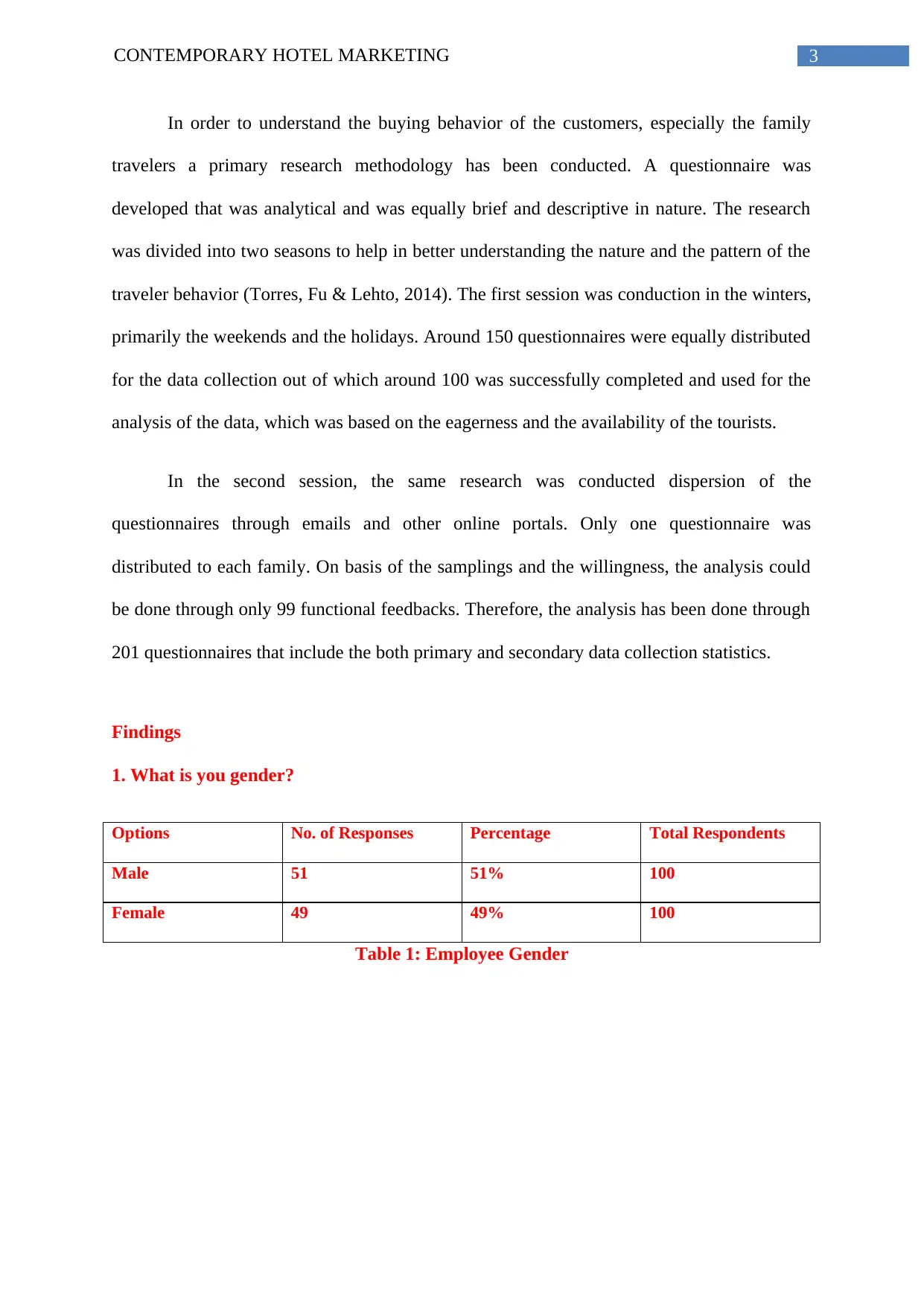
3CONTEMPORARY HOTEL MARKETING
In order to understand the buying behavior of the customers, especially the family
travelers a primary research methodology has been conducted. A questionnaire was
developed that was analytical and was equally brief and descriptive in nature. The research
was divided into two seasons to help in better understanding the nature and the pattern of the
traveler behavior (Torres, Fu & Lehto, 2014). The first session was conduction in the winters,
primarily the weekends and the holidays. Around 150 questionnaires were equally distributed
for the data collection out of which around 100 was successfully completed and used for the
analysis of the data, which was based on the eagerness and the availability of the tourists.
In the second session, the same research was conducted dispersion of the
questionnaires through emails and other online portals. Only one questionnaire was
distributed to each family. On basis of the samplings and the willingness, the analysis could
be done through only 99 functional feedbacks. Therefore, the analysis has been done through
201 questionnaires that include the both primary and secondary data collection statistics.
Findings
1. What is you gender?
Options No. of Responses Percentage Total Respondents
Male 51 51% 100
Female 49 49% 100
Table 1: Employee Gender
In order to understand the buying behavior of the customers, especially the family
travelers a primary research methodology has been conducted. A questionnaire was
developed that was analytical and was equally brief and descriptive in nature. The research
was divided into two seasons to help in better understanding the nature and the pattern of the
traveler behavior (Torres, Fu & Lehto, 2014). The first session was conduction in the winters,
primarily the weekends and the holidays. Around 150 questionnaires were equally distributed
for the data collection out of which around 100 was successfully completed and used for the
analysis of the data, which was based on the eagerness and the availability of the tourists.
In the second session, the same research was conducted dispersion of the
questionnaires through emails and other online portals. Only one questionnaire was
distributed to each family. On basis of the samplings and the willingness, the analysis could
be done through only 99 functional feedbacks. Therefore, the analysis has been done through
201 questionnaires that include the both primary and secondary data collection statistics.
Findings
1. What is you gender?
Options No. of Responses Percentage Total Respondents
Male 51 51% 100
Female 49 49% 100
Table 1: Employee Gender
Paraphrase This Document
Need a fresh take? Get an instant paraphrase of this document with our AI Paraphraser
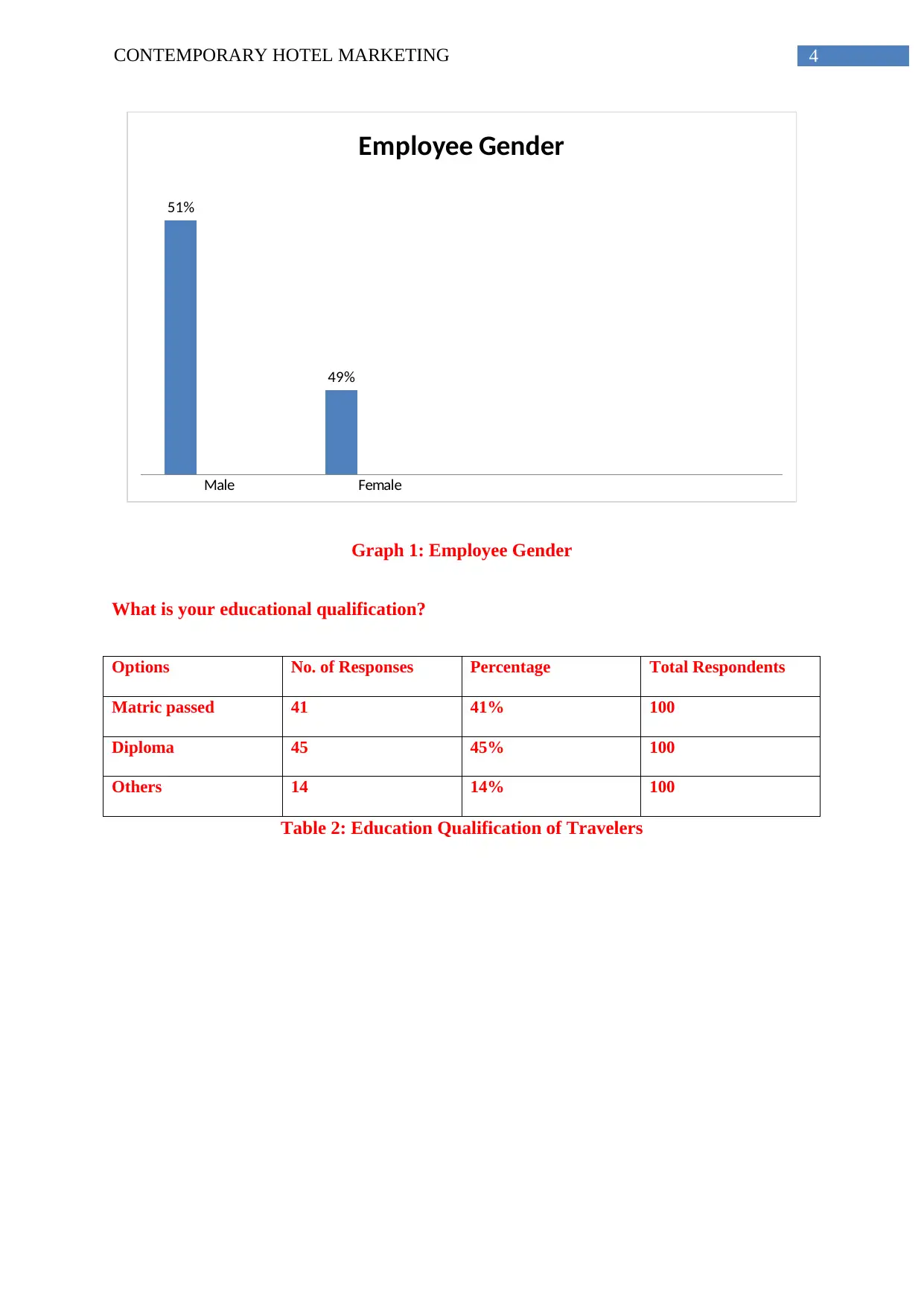
4CONTEMPORARY HOTEL MARKETING
Male Female
51%
49%
Employee Gender
Graph 1: Employee Gender
What is your educational qualification?
Options No. of Responses Percentage Total Respondents
Matric passed 41 41% 100
Diploma 45 45% 100
Others 14 14% 100
Table 2: Education Qualification of Travelers
Male Female
51%
49%
Employee Gender
Graph 1: Employee Gender
What is your educational qualification?
Options No. of Responses Percentage Total Respondents
Matric passed 41 41% 100
Diploma 45 45% 100
Others 14 14% 100
Table 2: Education Qualification of Travelers
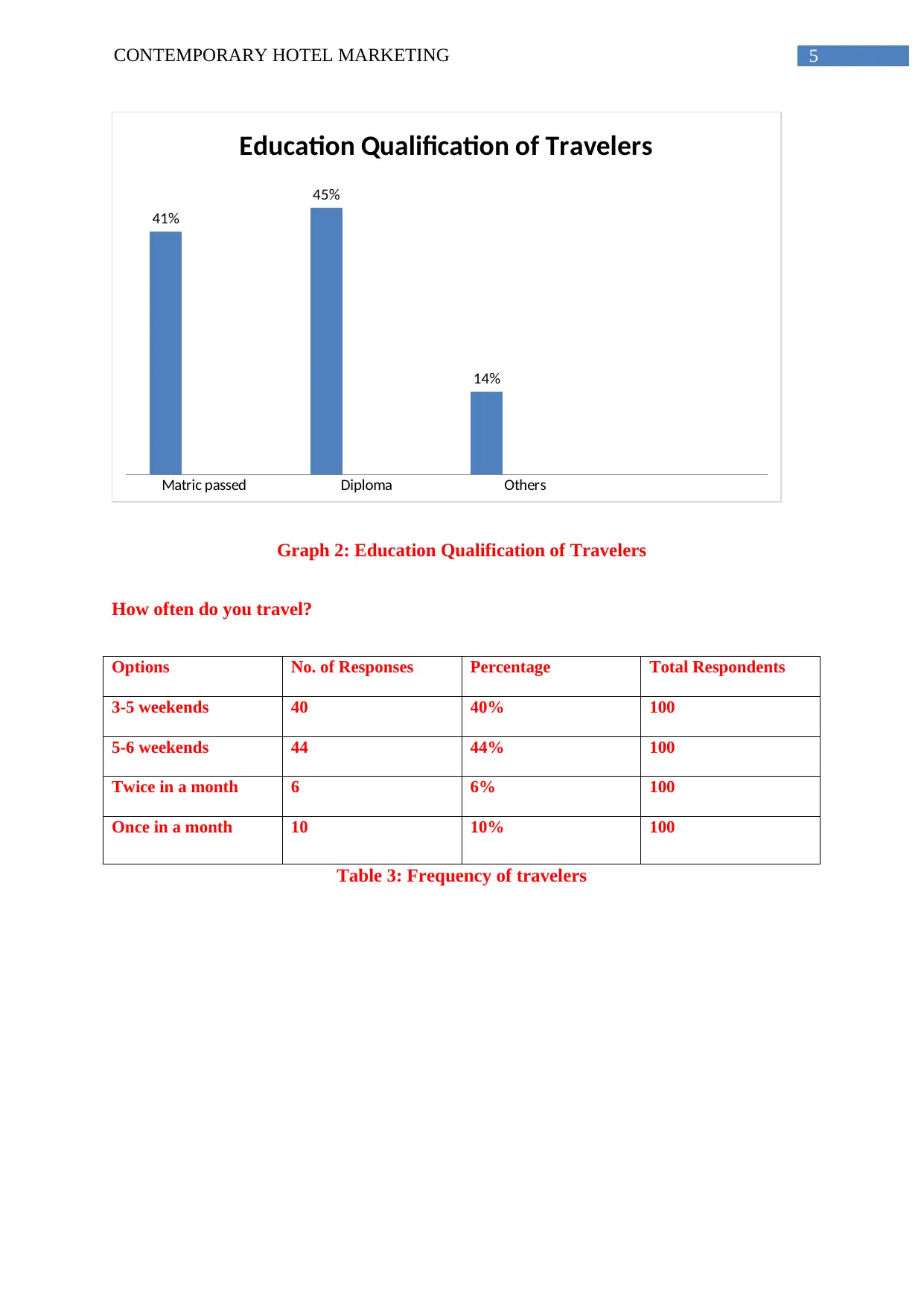
5CONTEMPORARY HOTEL MARKETING
Matric passed Diploma Others
41%
45%
14%
Education Qualification of Travelers
Graph 2: Education Qualification of Travelers
How often do you travel?
Options No. of Responses Percentage Total Respondents
3-5 weekends 40 40% 100
5-6 weekends 44 44% 100
Twice in a month 6 6% 100
Once in a month 10 10% 100
Table 3: Frequency of travelers
Matric passed Diploma Others
41%
45%
14%
Education Qualification of Travelers
Graph 2: Education Qualification of Travelers
How often do you travel?
Options No. of Responses Percentage Total Respondents
3-5 weekends 40 40% 100
5-6 weekends 44 44% 100
Twice in a month 6 6% 100
Once in a month 10 10% 100
Table 3: Frequency of travelers
⊘ This is a preview!⊘
Do you want full access?
Subscribe today to unlock all pages.

Trusted by 1+ million students worldwide
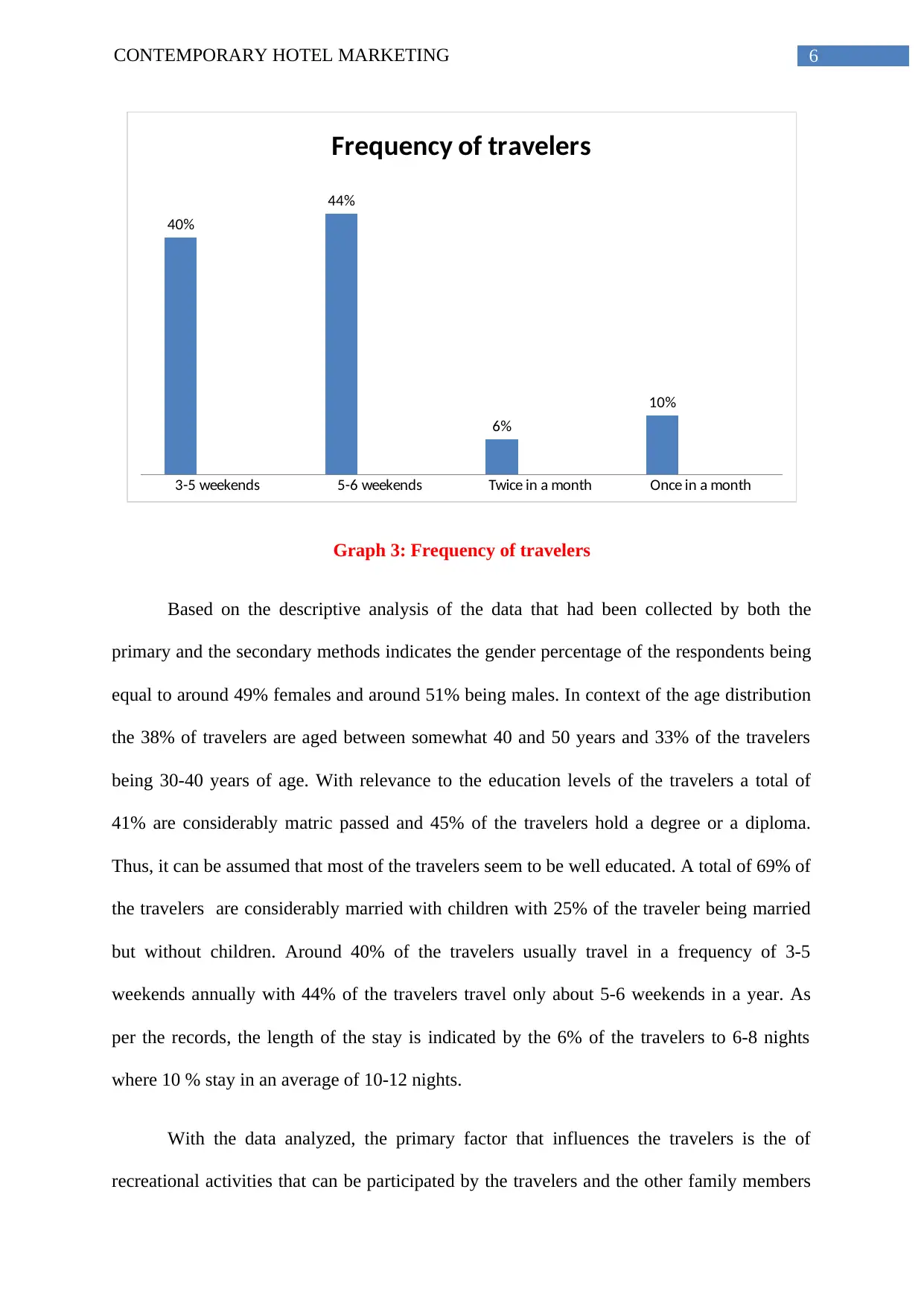
6CONTEMPORARY HOTEL MARKETING
3-5 weekends 5-6 weekends Twice in a month Once in a month
40%
44%
6%
10%
Frequency of travelers
Graph 3: Frequency of travelers
Based on the descriptive analysis of the data that had been collected by both the
primary and the secondary methods indicates the gender percentage of the respondents being
equal to around 49% females and around 51% being males. In context of the age distribution
the 38% of travelers are aged between somewhat 40 and 50 years and 33% of the travelers
being 30-40 years of age. With relevance to the education levels of the travelers a total of
41% are considerably matric passed and 45% of the travelers hold a degree or a diploma.
Thus, it can be assumed that most of the travelers seem to be well educated. A total of 69% of
the travelers are considerably married with children with 25% of the traveler being married
but without children. Around 40% of the travelers usually travel in a frequency of 3-5
weekends annually with 44% of the travelers travel only about 5-6 weekends in a year. As
per the records, the length of the stay is indicated by the 6% of the travelers to 6-8 nights
where 10 % stay in an average of 10-12 nights.
With the data analyzed, the primary factor that influences the travelers is the of
recreational activities that can be participated by the travelers and the other family members
3-5 weekends 5-6 weekends Twice in a month Once in a month
40%
44%
6%
10%
Frequency of travelers
Graph 3: Frequency of travelers
Based on the descriptive analysis of the data that had been collected by both the
primary and the secondary methods indicates the gender percentage of the respondents being
equal to around 49% females and around 51% being males. In context of the age distribution
the 38% of travelers are aged between somewhat 40 and 50 years and 33% of the travelers
being 30-40 years of age. With relevance to the education levels of the travelers a total of
41% are considerably matric passed and 45% of the travelers hold a degree or a diploma.
Thus, it can be assumed that most of the travelers seem to be well educated. A total of 69% of
the travelers are considerably married with children with 25% of the traveler being married
but without children. Around 40% of the travelers usually travel in a frequency of 3-5
weekends annually with 44% of the travelers travel only about 5-6 weekends in a year. As
per the records, the length of the stay is indicated by the 6% of the travelers to 6-8 nights
where 10 % stay in an average of 10-12 nights.
With the data analyzed, the primary factor that influences the travelers is the of
recreational activities that can be participated by the travelers and the other family members
Paraphrase This Document
Need a fresh take? Get an instant paraphrase of this document with our AI Paraphraser
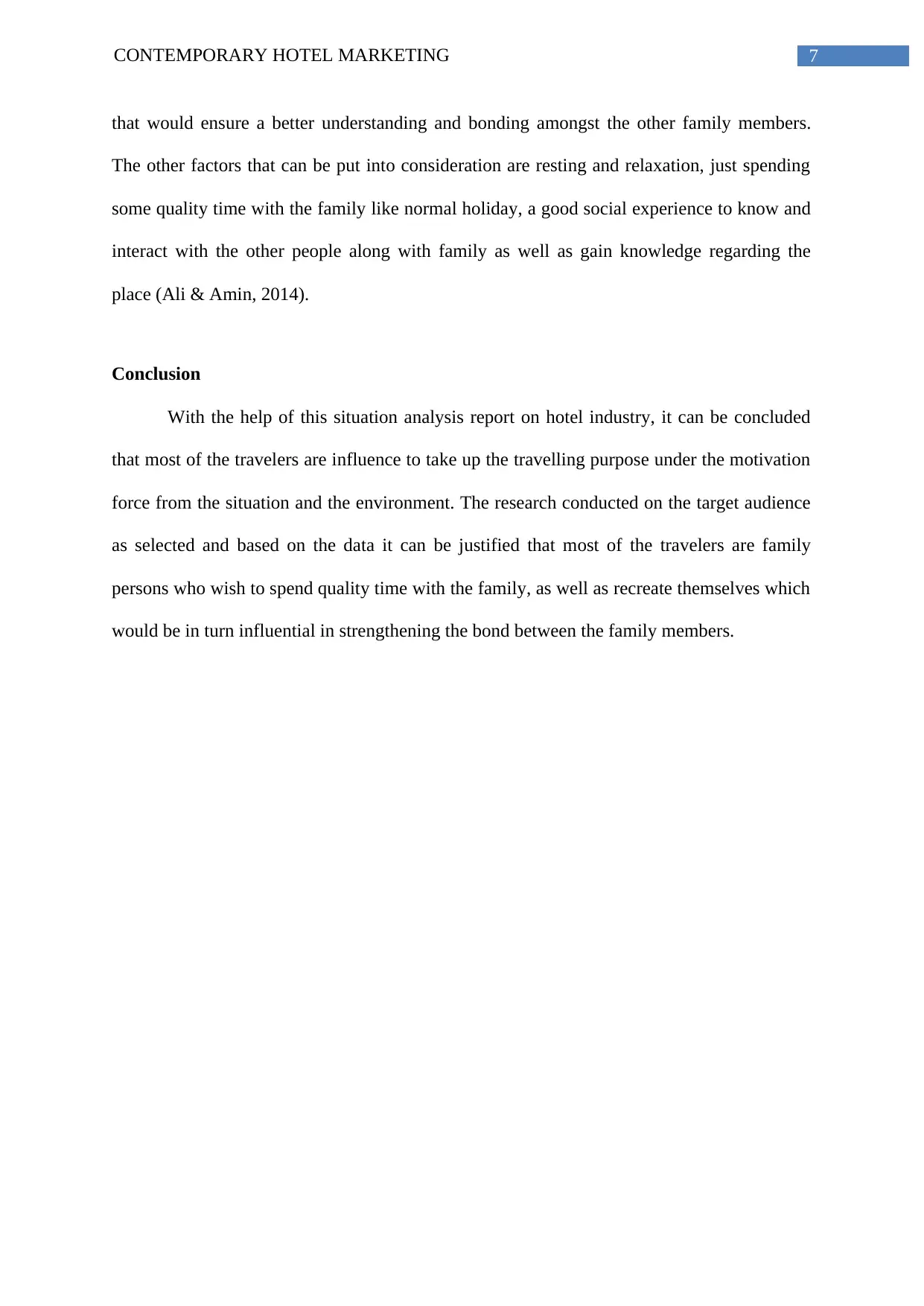
7CONTEMPORARY HOTEL MARKETING
that would ensure a better understanding and bonding amongst the other family members.
The other factors that can be put into consideration are resting and relaxation, just spending
some quality time with the family like normal holiday, a good social experience to know and
interact with the other people along with family as well as gain knowledge regarding the
place (Ali & Amin, 2014).
Conclusion
With the help of this situation analysis report on hotel industry, it can be concluded
that most of the travelers are influence to take up the travelling purpose under the motivation
force from the situation and the environment. The research conducted on the target audience
as selected and based on the data it can be justified that most of the travelers are family
persons who wish to spend quality time with the family, as well as recreate themselves which
would be in turn influential in strengthening the bond between the family members.
that would ensure a better understanding and bonding amongst the other family members.
The other factors that can be put into consideration are resting and relaxation, just spending
some quality time with the family like normal holiday, a good social experience to know and
interact with the other people along with family as well as gain knowledge regarding the
place (Ali & Amin, 2014).
Conclusion
With the help of this situation analysis report on hotel industry, it can be concluded
that most of the travelers are influence to take up the travelling purpose under the motivation
force from the situation and the environment. The research conducted on the target audience
as selected and based on the data it can be justified that most of the travelers are family
persons who wish to spend quality time with the family, as well as recreate themselves which
would be in turn influential in strengthening the bond between the family members.
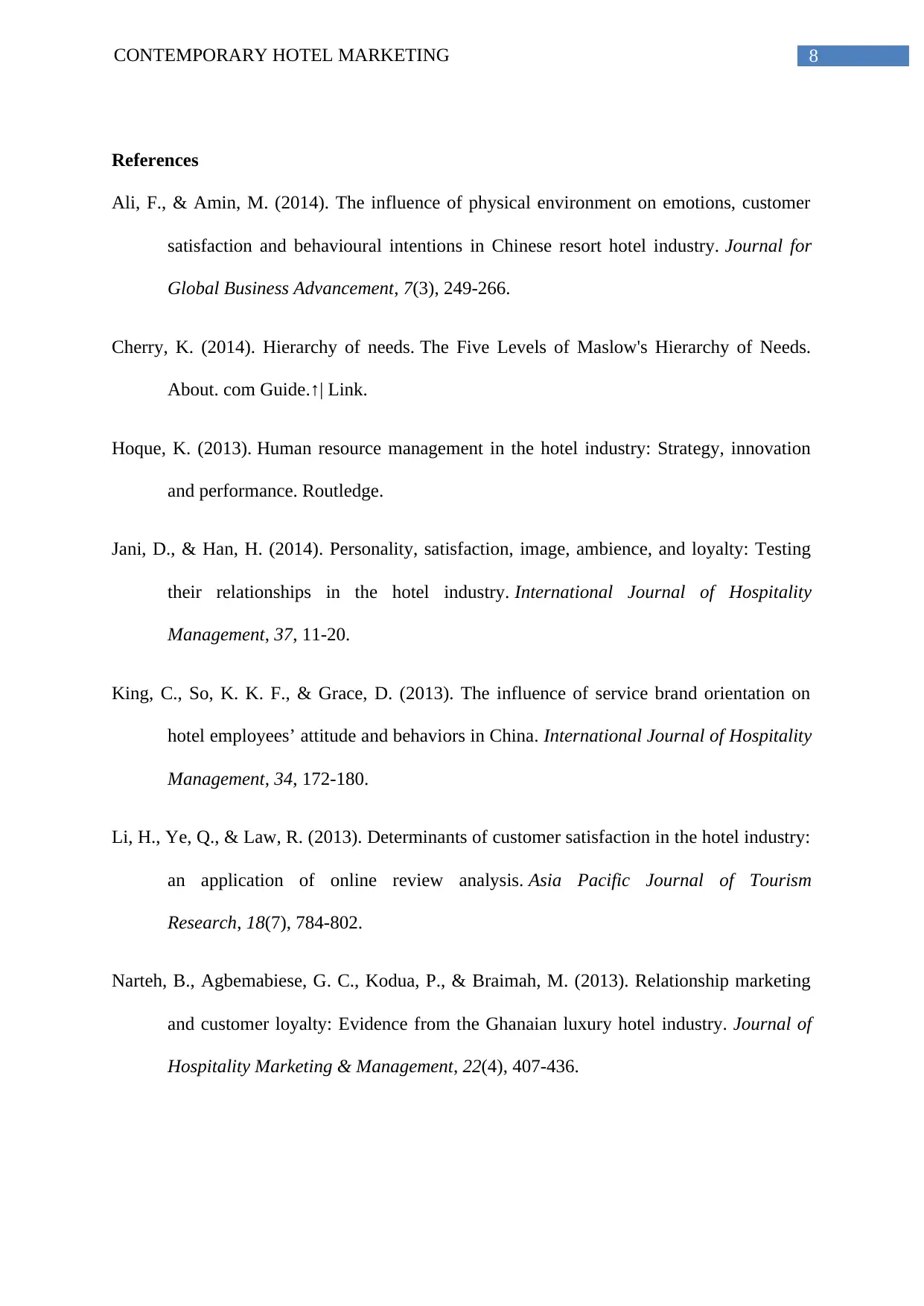
8CONTEMPORARY HOTEL MARKETING
References
Ali, F., & Amin, M. (2014). The influence of physical environment on emotions, customer
satisfaction and behavioural intentions in Chinese resort hotel industry. Journal for
Global Business Advancement, 7(3), 249-266.
Cherry, K. (2014). Hierarchy of needs. The Five Levels of Maslow's Hierarchy of Needs.
About. com Guide.↑| Link.
Hoque, K. (2013). Human resource management in the hotel industry: Strategy, innovation
and performance. Routledge.
Jani, D., & Han, H. (2014). Personality, satisfaction, image, ambience, and loyalty: Testing
their relationships in the hotel industry. International Journal of Hospitality
Management, 37, 11-20.
King, C., So, K. K. F., & Grace, D. (2013). The influence of service brand orientation on
hotel employees’ attitude and behaviors in China. International Journal of Hospitality
Management, 34, 172-180.
Li, H., Ye, Q., & Law, R. (2013). Determinants of customer satisfaction in the hotel industry:
an application of online review analysis. Asia Pacific Journal of Tourism
Research, 18(7), 784-802.
Narteh, B., Agbemabiese, G. C., Kodua, P., & Braimah, M. (2013). Relationship marketing
and customer loyalty: Evidence from the Ghanaian luxury hotel industry. Journal of
Hospitality Marketing & Management, 22(4), 407-436.
References
Ali, F., & Amin, M. (2014). The influence of physical environment on emotions, customer
satisfaction and behavioural intentions in Chinese resort hotel industry. Journal for
Global Business Advancement, 7(3), 249-266.
Cherry, K. (2014). Hierarchy of needs. The Five Levels of Maslow's Hierarchy of Needs.
About. com Guide.↑| Link.
Hoque, K. (2013). Human resource management in the hotel industry: Strategy, innovation
and performance. Routledge.
Jani, D., & Han, H. (2014). Personality, satisfaction, image, ambience, and loyalty: Testing
their relationships in the hotel industry. International Journal of Hospitality
Management, 37, 11-20.
King, C., So, K. K. F., & Grace, D. (2013). The influence of service brand orientation on
hotel employees’ attitude and behaviors in China. International Journal of Hospitality
Management, 34, 172-180.
Li, H., Ye, Q., & Law, R. (2013). Determinants of customer satisfaction in the hotel industry:
an application of online review analysis. Asia Pacific Journal of Tourism
Research, 18(7), 784-802.
Narteh, B., Agbemabiese, G. C., Kodua, P., & Braimah, M. (2013). Relationship marketing
and customer loyalty: Evidence from the Ghanaian luxury hotel industry. Journal of
Hospitality Marketing & Management, 22(4), 407-436.
⊘ This is a preview!⊘
Do you want full access?
Subscribe today to unlock all pages.

Trusted by 1+ million students worldwide
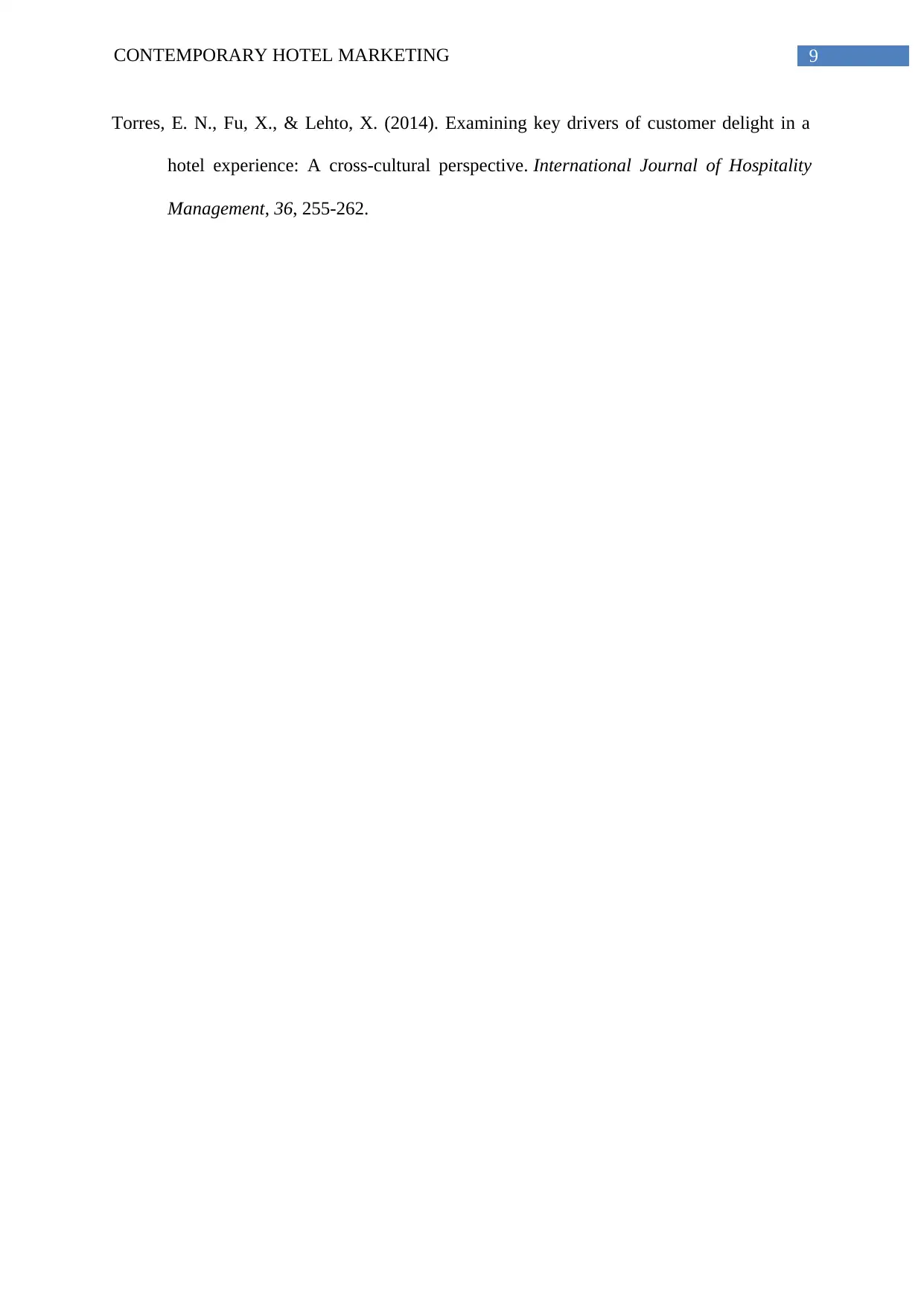
9CONTEMPORARY HOTEL MARKETING
Torres, E. N., Fu, X., & Lehto, X. (2014). Examining key drivers of customer delight in a
hotel experience: A cross-cultural perspective. International Journal of Hospitality
Management, 36, 255-262.
Torres, E. N., Fu, X., & Lehto, X. (2014). Examining key drivers of customer delight in a
hotel experience: A cross-cultural perspective. International Journal of Hospitality
Management, 36, 255-262.
1 out of 10
Related Documents
Your All-in-One AI-Powered Toolkit for Academic Success.
+13062052269
info@desklib.com
Available 24*7 on WhatsApp / Email
![[object Object]](/_next/static/media/star-bottom.7253800d.svg)
Unlock your academic potential
Copyright © 2020–2025 A2Z Services. All Rights Reserved. Developed and managed by ZUCOL.




